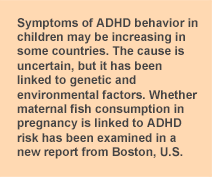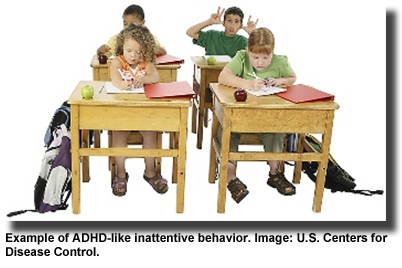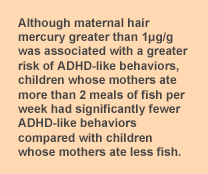
Attention deficit/hyperactivity disorder (ADHD), a common childhood behavioral disorder, may be increasing. Worldwide, ADHD affects about 8% to 12% of school-age children, with some estimates closer to 5%. In the U.S., the prevalence increased from 7.5% to 9.0% from 2001 to 2007. As the criteria for determining ADHD have changed, more cases may be identified. Even with uncertain numbers, the condition puts a burden on families, teachers and health care providers, as treatments are limited. We do not know the causes of ADHD, but genetic and environmental factors, such as organic contaminants have been suggested. Prenatal exposure to mercury has been linked to ADHD in at least one long-term study, but no evidence of association was observed in another.

Investigators in Boston, U.S., took a fresh look at the possible association between prenatal mercury exposure and ADHD-like behaviors in children 8 years later. The researchers had data on fish consumption and the mothers’ hair mercury content from a sample of women living close to a contaminated harbor into which PCBs and other contaminants had been discharged decades ago. The children were given various neuropsychological tests that reflect the symptoms of ADHD, but were not clinically evaluated for the condition. For example, the evaluations included inattentive, impulsive and hyperactive behaviors and combinations of these. The investigators analyzed the test results to see whether the children’s behaviors were related to the mothers’ hair mercury levels. They observed a significant increase in the risk of inattentive and impulsive/hyperactive behaviors once hair mercury levels reached or exceeded 1μg/g. When the mothers’ fish consumption was taken into consideration, the higher risks with hair mercury above 1 μg/g remained. For comparison, hair mercury levels in a national sample of U.S. women are half that amount.

However, when the mothers’ fish consumption was evaluated for a link to the children’s behavioral scores, risk of higher scores was significantly reduced for children whose mothers ate more than 2 meals of fish per week. When the analysis took into account the exposure to mercury, test scores were still significantly lower; that is, fewer problem behaviors in the children whose mothers ate fish. Thus, in spite of being exposed to mercury, the children of mothers who consumed more than 2 meals of fish per week experienced fewer ADHD-like behaviors. These children also had higher mental processing speeds and improved distractibility scores compared with children whose mothers ate less than 2 meals of fish per week. These findings support those described in the preceding article in which children in the Seychelle Islands whose mothers consumed plenty of fish had higher performances in behavioral, language and other neurodevelopmental evaluations than children whose mothers ate little or no fish. They are also consistent with reports from a long-term study in the U.K. where children whose mothers ate more than 340 g/week (12 ounces) were significantly less likely to develop social, behavioral or other learning difficulties compared with the children whose mothers did not eat fish. Continued reports about the benefits to children’s and adults’ health associated with frequent fish consumption continue to provide a strong basis for concluding that the benefits of eating fish considerably outweigh the risks that might accrue from exposure to contaminants.
 Attention deficit/hyperactivity disorder (ADHD), a common childhood behavioral disorder, may be increasing. Worldwide, ADHD affects about 8% to 12% of school-age children, with some estimates closer to 5%. In the U.S., the prevalence increased from 7.5% to 9.0% from 2001 to 2007. As the criteria for determining ADHD have changed, more cases may be identified. Even with uncertain numbers, the condition puts a burden on families, teachers and health care providers, as treatments are limited. We do not know the causes of ADHD, but genetic and environmental factors, such as organic contaminants have been suggested. Prenatal exposure to mercury has been linked to ADHD in at least one long-term study, but no evidence of association was observed in another.
Attention deficit/hyperactivity disorder (ADHD), a common childhood behavioral disorder, may be increasing. Worldwide, ADHD affects about 8% to 12% of school-age children, with some estimates closer to 5%. In the U.S., the prevalence increased from 7.5% to 9.0% from 2001 to 2007. As the criteria for determining ADHD have changed, more cases may be identified. Even with uncertain numbers, the condition puts a burden on families, teachers and health care providers, as treatments are limited. We do not know the causes of ADHD, but genetic and environmental factors, such as organic contaminants have been suggested. Prenatal exposure to mercury has been linked to ADHD in at least one long-term study, but no evidence of association was observed in another.  Investigators in Boston, U.S., took a fresh look at the possible association between prenatal mercury exposure and ADHD-like behaviors in children 8 years later. The researchers had data on fish consumption and the mothers’ hair mercury content from a sample of women living close to a contaminated harbor into which PCBs and other contaminants had been discharged decades ago. The children were given various neuropsychological tests that reflect the symptoms of ADHD, but were not clinically evaluated for the condition. For example, the evaluations included inattentive, impulsive and hyperactive behaviors and combinations of these. The investigators analyzed the test results to see whether the children’s behaviors were related to the mothers’ hair mercury levels. They observed a significant increase in the risk of inattentive and impulsive/hyperactive behaviors once hair mercury levels reached or exceeded 1μg/g. When the mothers’ fish consumption was taken into consideration, the higher risks with hair mercury above 1 μg/g remained. For comparison, hair mercury levels in a national sample of U.S. women are half that amount.
Investigators in Boston, U.S., took a fresh look at the possible association between prenatal mercury exposure and ADHD-like behaviors in children 8 years later. The researchers had data on fish consumption and the mothers’ hair mercury content from a sample of women living close to a contaminated harbor into which PCBs and other contaminants had been discharged decades ago. The children were given various neuropsychological tests that reflect the symptoms of ADHD, but were not clinically evaluated for the condition. For example, the evaluations included inattentive, impulsive and hyperactive behaviors and combinations of these. The investigators analyzed the test results to see whether the children’s behaviors were related to the mothers’ hair mercury levels. They observed a significant increase in the risk of inattentive and impulsive/hyperactive behaviors once hair mercury levels reached or exceeded 1μg/g. When the mothers’ fish consumption was taken into consideration, the higher risks with hair mercury above 1 μg/g remained. For comparison, hair mercury levels in a national sample of U.S. women are half that amount.  However, when the mothers’ fish consumption was evaluated for a link to the children’s behavioral scores, risk of higher scores was significantly reduced for children whose mothers ate more than 2 meals of fish per week. When the analysis took into account the exposure to mercury, test scores were still significantly lower; that is, fewer problem behaviors in the children whose mothers ate fish. Thus, in spite of being exposed to mercury, the children of mothers who consumed more than 2 meals of fish per week experienced fewer ADHD-like behaviors. These children also had higher mental processing speeds and improved distractibility scores compared with children whose mothers ate less than 2 meals of fish per week. These findings support those described in the preceding article in which children in the Seychelle Islands whose mothers consumed plenty of fish had higher performances in behavioral, language and other neurodevelopmental evaluations than children whose mothers ate little or no fish. They are also consistent with reports from a long-term study in the U.K. where children whose mothers ate more than 340 g/week (12 ounces) were significantly less likely to develop social, behavioral or other learning difficulties compared with the children whose mothers did not eat fish. Continued reports about the benefits to children’s and adults’ health associated with frequent fish consumption continue to provide a strong basis for concluding that the benefits of eating fish considerably outweigh the risks that might accrue from exposure to contaminants.
However, when the mothers’ fish consumption was evaluated for a link to the children’s behavioral scores, risk of higher scores was significantly reduced for children whose mothers ate more than 2 meals of fish per week. When the analysis took into account the exposure to mercury, test scores were still significantly lower; that is, fewer problem behaviors in the children whose mothers ate fish. Thus, in spite of being exposed to mercury, the children of mothers who consumed more than 2 meals of fish per week experienced fewer ADHD-like behaviors. These children also had higher mental processing speeds and improved distractibility scores compared with children whose mothers ate less than 2 meals of fish per week. These findings support those described in the preceding article in which children in the Seychelle Islands whose mothers consumed plenty of fish had higher performances in behavioral, language and other neurodevelopmental evaluations than children whose mothers ate little or no fish. They are also consistent with reports from a long-term study in the U.K. where children whose mothers ate more than 340 g/week (12 ounces) were significantly less likely to develop social, behavioral or other learning difficulties compared with the children whose mothers did not eat fish. Continued reports about the benefits to children’s and adults’ health associated with frequent fish consumption continue to provide a strong basis for concluding that the benefits of eating fish considerably outweigh the risks that might accrue from exposure to contaminants.

